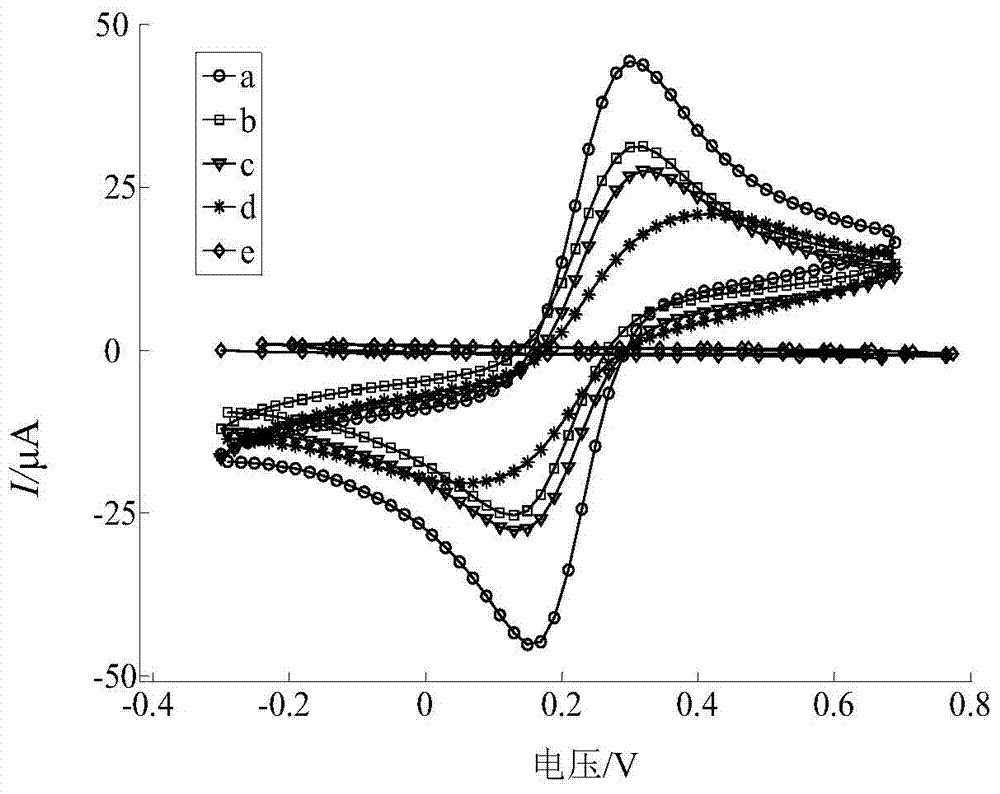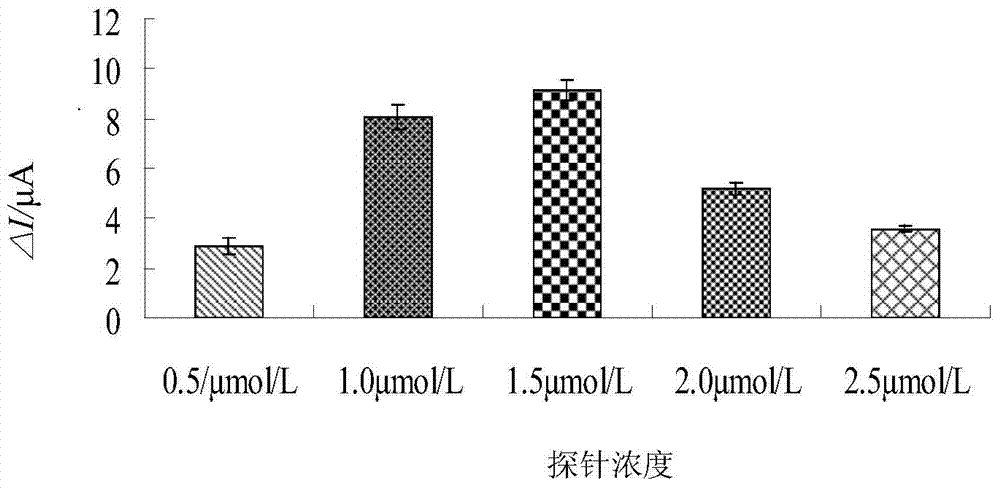NDM-1 locked nucleic acid probe modified electrode as well as preparation method and application thereof
A technology of locking nucleic acid probes and modifying electrodes, which is applied in the field of electrochemical detection, can solve the problems of high detection cost, time-consuming and cumbersome diagnostic methods, low sensitivity and specificity, and achieve the effect of specific detection tools
- Summary
- Abstract
- Description
- Claims
- Application Information
AI Technical Summary
Problems solved by technology
Method used
Image
Examples
Embodiment 1
[0028] The preparation method of NDM-1 locking nucleic acid probe modified electrode comprises the following steps:
[0029] a. Cleaning of the gold electrode: take a gold electrode with a diameter of 3 mm, and use 0.3 μm and 0.05 μm Al respectively 2 o 3 The powder was ground and polished to a mirror surface, rinsed with ultra-pure water after each grinding, and then ultrasonically washed in nitric acid, acetone, and ultra-pure water for 5 minutes respectively, and dried to obtain a cleaned gold electrode for future use.
[0030] b. Immobilization of LNA probes: Take 20 μL of NDM-1 LNA probe solution with a concentration of 1.5 μmol / L modified thiol at the 5’ end and drop it on the surface of the cleaned gold electrode, and then keep the temperature in an incubator at 37°C for 1 Hours, the locked nucleic acid is modified to the surface of the electrode through the chemical bonding of the Au-S bond, and then the electrode is immersed in a mercaptohexanol solution with a conce...
Embodiment 2
[0032] Embodiment 2, build the electrochemical biosensor that detects NDM-1
[0033] The NDM-1-locked nucleic acid probe-modified electrode was used as the working electrode, the saturated calomel electrode was used as the reference electrode, and the platinum electrode was used as the counter electrode to form an electrochemical biosensor for detecting NDM-1. Connect the prepared electrochemical sensor to the electrochemical workstation, and use pH 7.4 containing 2mmol / L K 3 Fe(CN) 6 -K 4 Fe(CN) 6 , 5mmol KCl in PBS was used as the test base solution, and then the scanning measurement was carried out by cyclic voltammetry at room temperature, the working potential was -0.3V~0.7V, and the scanning speed was 50mV / s. The detection principle of the electrochemical biosensor for detecting NDM-1 is as follows: after the hybridization reaction occurs on the surface of the electrode modified by NDM-1 locked nucleic acid probe, the hybrid complex formed hinders the electron transfe...
Embodiment 3
[0034] Example 3, Detection of Electrochemical Properties of NDM-1 Locked Nucleic Acid Probe Modified Electrode
[0035] Use cyclic voltammetry to characterize the electrochemical characteristics of the electrode during the modification and detection process. The specific detection method is: after the electrodes at different stages are constructed as an electrochemical biosensor according to the method in Example 2, the electrodes are soaked in 150 μL NDM-1 In a solution (pH7.40.1 mol / L phosphate solution) with a final concentration of the target sequence of 100 μg / L, hybridize in a 37° C. incubator for 45 minutes. During the hybridization process, the sensor uses a three-electrode system to measure the sensor current, and the obtained cyclic voltammetry curve is as follows: figure 1 shown.
[0036] Among them, curve a is that the bare gold electrode contains 2mmol / L K at pH7.4 3 [Fe(CN) 6 ] / K 4 [Fe(CN) 6 ] and the cyclic voltammetry curve in PBS solution of 5mmol / l KCl,...
PUM
| Property | Measurement | Unit |
|---|---|---|
| Diameter | aaaaa | aaaaa |
Abstract
Description
Claims
Application Information
 Login to View More
Login to View More - R&D
- Intellectual Property
- Life Sciences
- Materials
- Tech Scout
- Unparalleled Data Quality
- Higher Quality Content
- 60% Fewer Hallucinations
Browse by: Latest US Patents, China's latest patents, Technical Efficacy Thesaurus, Application Domain, Technology Topic, Popular Technical Reports.
© 2025 PatSnap. All rights reserved.Legal|Privacy policy|Modern Slavery Act Transparency Statement|Sitemap|About US| Contact US: help@patsnap.com



